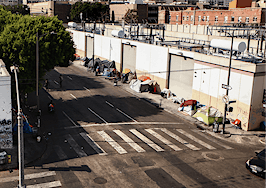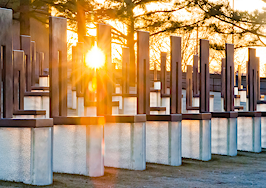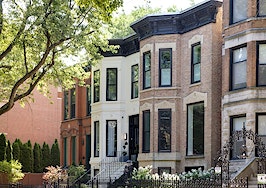According to the Department of Housing and Urban Development’s 2018 Point-in-Time Count, there are 552,830 homeless people in the United States — a 1,834-person increase from 2017.
Communities across the nation are struggling to solve the issue and often rely on poorly funded shelters, temporary housing programs and law enforcement to keep people off the streets. Even cities with well-funded programs are falling behind — Los Angeles and New York City have spent billions to end homelessness with little results.
So, what’s the solution?
According to nonprofit Community Solutions, the key to ending chronic homelessness is real-time data aggregation and tracking that enables communities to make smart, quick decisions.
“It really is a very radical idea that without real-time, person-specific information, communities just can’t pool everything they’ve got together and be accountable at solving the problem,” Community Solutions President Rosanne Haggerty told Fast Company in March.
The nonprofit’s Built for Zero program helps local agencies transform their databases from statistical wastelands to a treasure trove of rich, by-name data.
Powered by Tableau, the Built for Zero database requires each homeless person to be listed by name. From there, agencies will enter additional demographic information, keep track of the person’s whereabouts, and how long they’ve been homeless.
Haggerty says this information allows agencies to prioritize those who are chronically homeless (e.g., have been homeless for a year or more) and conduct interventions with landlords and public housing for those who are at risk of becoming homeless.
As a result, three of the 68 communities in the program have reached the goal of functional zero for chronic homelessness. Another 10 have done the same for veteran homelessness.

“Your community has ended veteran homelessness when the number of veterans experiencing homelessness falls below your average monthly housing placement rate,” read an explainer on the Built for Zero site. A city is considered to have ended chronic homelessness when the number of chronically homeless people falls to 3 or less, or .1% of a city’s most recent point-in-time count, whichever is greater.
In 2017, Bergen County, New Jersey, was the first community to reach functional zero — no small feat for a population topping 1 million. The county has maintained its status thanks to the database and a “housing first” initiative that provides homeless residents with permanent housing before connecting them with other services.
More recently, the county was able to identify and solve an uptick in homelessness among youth and seniors.
“The data is so important because by the time you know it’s a problem, it’s too late,” Bergen County Housing, Health and Human Service Center director Julia Orlando told Fast Company. “So, if you can start seeing trends before it’s a really bad problem, you can start adjusting your policies or trying to get additional services in your facility to try to address that.”
Alongside Bergen County, Rockford, Illinois, has achieved functional zero for both chronic homelessness and veteran homelessness.
Lancaster, Pennsylvania, has eliminated chronic homelessness, and Arlington, Virginia; Montgomery County, Maryland; Fort Myers, Florida; Gulfport, Mississippi; Riverside, California; Norman, Oklahoma; Abilene, Texas, and Lake County, Illinois have all ended veteran homelessness.
Even with the success they’ve experienced in smaller communities, Built for Zero acknowledges the real test lies in metros like New York City, San Francisco, Los Angeles and Seattle.
San Francisco and Los Angeles have made headlines in recent months for how they’ve handled homelessness.
In September, residents of San Francisco’s Mission Dolores neighborhood placed 24, 100-pound boulders on a sidewalk to keep homeless residents away. Homelessness advocates called the boulders an example of anti-homeless architecture and admonished the Public Works Department for their initial support.
A few weeks later, Los Angeles was in the spotlight after City Controller Ron Galperin’s yearly assessment of Proposition HHH, a plan that uses $1.2 billion in general obligation bonds to help fund the construction of supportive housing units. Three years in, Los Angeles has only completed 117 units — a far cry from the 10,000 unit goal.
Haggerty hopes cities like San Francisco and LA will join Built for Zero, as the program’s 2020 application window opens this month. The application process includes a short questionnaire and proof that a community has these five things:
- A clear, community-wide goal to end homelessness for veterans and/or individuals experiencing chronic homelessness.
- A committed multi-agency team of leaders who can take ownership of setting goals and coordinate your systems improvement work. That team should include groups like your VA and your local Continuum of Care.
- Someone to drive your team forward.
- Monthly data reporting and readiness to reach new data quality thresholds.
- Participation in the Built for Zero national peer support network.
In addition to bringing new communities into the fold, Built for Zero is upping the ante for current members. The organization hopes to have 13 functionally zero cities in 2020 by offering additional funding to 50 communities.
“We thought by focusing on the 50 cities, it would become a tipping point, where the discussion around whether or not homelessness could be solved really was put to rest,” Tableau Foundation global head Neal Myrick told Fast Company while explaining they’d donate $1.3 million to the goal. “It becomes more about, how are we going to solve it? With limited resources for everything, we think it’s really important to just start solving the problems that can be solved.”












